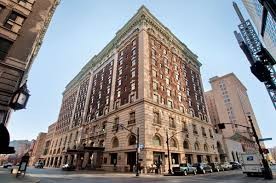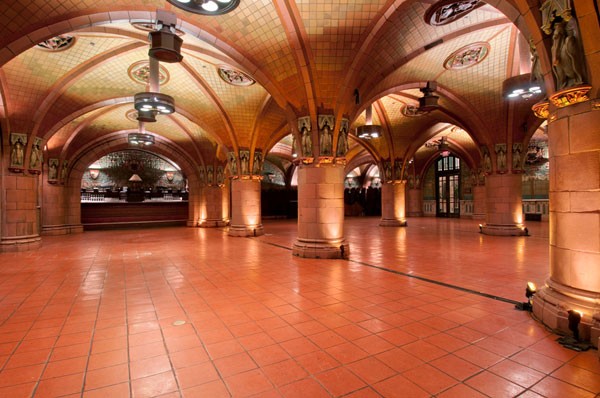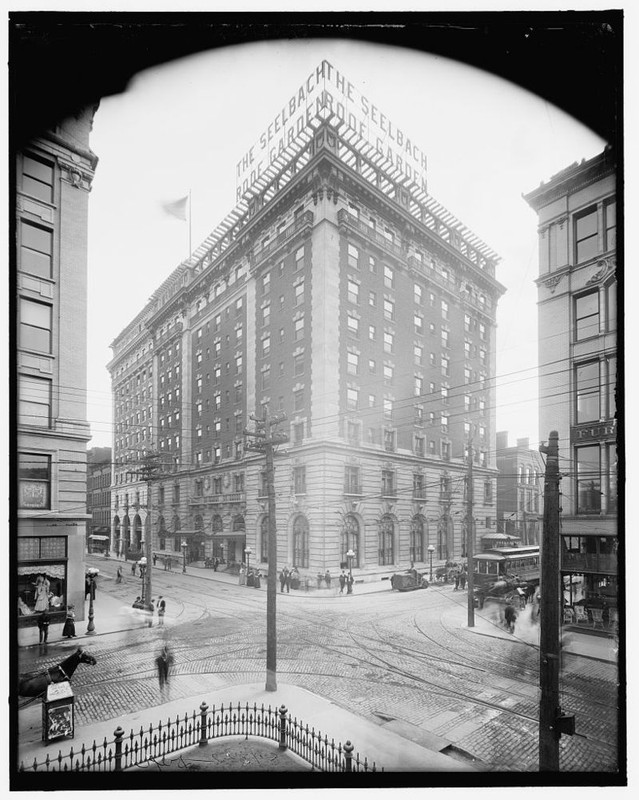Seelbach Hotel
Introduction
Text-to-speech Audio
Completed in 1905, this iconic hotel may be best-known for inspiring several scenes in F. Scott Fitzgerald's most famous work, The Great Gatsby. Although the author did not identify the Seelbach Hotel by name in the novel, it was here where he spent much of his time as a young soldier on leave. The hotel's interior and its colorful guests, as well as the setting of Tom and Daisy Buchanan's wedding, were drawn from his memories of the Seelbach. Renovated to resemble its former appearance with modern convienences, including larger rooms than was typical for the early 20th century, the hotel retains much of its character and historic grandeur even if it is now part of the Hilton chain. For residents and visitors to Louisville, this architectural masterpiece is one of the city's iconic buildings and one of its leading historic landmarks. The hotel has been frequented by eight U.S. Presidents, leading movie stars, and some of the most infamous gangsters who made their living from the hotel's underground Rathskeller which was full of illicit liquor during the Prohibition. Today, the hotel is now known for a more as a leading destination for conventions, social events, and travelers to the city seeking a genteel atmosphere and Southern hospitality.
Images
The Seelbach Hilton is both a historic landmark and a fine example of the Beaux Arts architectural design that was popular at the turn-of-the-century.

The Seelbach's Bavarian-style Rathskeller (a German word for a subterranean barroom) is decorated with rare Rookwood Pottery.

This historic photo was taken shortly after the hotel opened in 1905.

Backstory and Context
Text-to-speech Audio
The current Seelbach hotel opened in the spring of 1905 as a 150-room hotel operated by Bavarian immigrant brothers, Otto and Louis Seelbach. The hotel was the result of their successful restaurant which opened in 1886 and later expanded to include a hotel. The "new" Seelbach Hotel billed itself as "turn-of-the-century Beaux Arts Baroque Hotel." Within a few years, the hotel had expanded to five hundred rooms and became the leading hotel of the city.
During the era of Prohibition, the continued production of bourbon in this region attracted wealthy travelers who appreciated the Seelbach's capacity to serve alcoholic beverages with discretion. Prominent bootleggers from around the country were even more intrigued, with men such as George Remus and possibly even Al Capone becoming frequent visitors at the Seelbach.
F. Scott Fitzgerald also became a regular visitor of the Seelbach. While in the army, Fitzgerald trained at Camp Taylor, a former training base about six miles southeast of the city. Fitzgerald's love of good whiskey and expensive cigars brought him to the Seelbach, where his observation of characters of wealth and privilege spurred his imagination. It was at this time that Fitzgerald began planning his most famous novel, the Great Gatsby.
Fitzgerald based the character Jay Gatsby upon his encounters with bootlegger George Remus. He also chose the Grand Ballroom as the most appropriate setting for two other characters, Tom and Daisy Buchanan, to be married.
The Seelbach closed during the 1970s-a result of both a recession and the decline of downtown areas as centers of recreation and hospitality. The Seelbach was renovated and reopened in 1982. The hotel is presently operated by the Hilton chain. Like the Seelbach, the surrounding area has also enjoyed the return of tourism and hospitality in downtown Louisville.
During the era of Prohibition, the continued production of bourbon in this region attracted wealthy travelers who appreciated the Seelbach's capacity to serve alcoholic beverages with discretion. Prominent bootleggers from around the country were even more intrigued, with men such as George Remus and possibly even Al Capone becoming frequent visitors at the Seelbach.
F. Scott Fitzgerald also became a regular visitor of the Seelbach. While in the army, Fitzgerald trained at Camp Taylor, a former training base about six miles southeast of the city. Fitzgerald's love of good whiskey and expensive cigars brought him to the Seelbach, where his observation of characters of wealth and privilege spurred his imagination. It was at this time that Fitzgerald began planning his most famous novel, the Great Gatsby.
Fitzgerald based the character Jay Gatsby upon his encounters with bootlegger George Remus. He also chose the Grand Ballroom as the most appropriate setting for two other characters, Tom and Daisy Buchanan, to be married.
The Seelbach closed during the 1970s-a result of both a recession and the decline of downtown areas as centers of recreation and hospitality. The Seelbach was renovated and reopened in 1982. The hotel is presently operated by the Hilton chain. Like the Seelbach, the surrounding area has also enjoyed the return of tourism and hospitality in downtown Louisville.
Sources
Carrie Harned, "Secret Life of the Seelbach Hotel," WAVE 3 Media website, accessed 10/10/116 http://www.wave3.com/story/1268043/the-secret-life-of-the-seelbach-hotel
"The Seelbach Experience," Seelbach Hilton website, (accessed 10/10/16) http://www.seelbachhilton.com/03_a_historic.php
